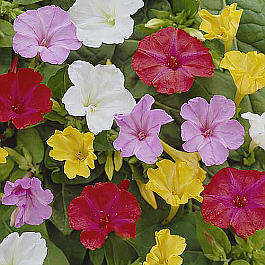|
Anti-Inflammatory / Anti-fungal, bacterial, viral
Vermifugal / Diuretic / Aid in Digestion
Clavillia
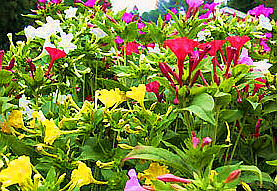
Clavillia
(Mirabilis jalapa)
Code: BOS232 -- Price: $18.95
120 Capsules x 500 mg.
Order Now
 Email
Email
 Summarized Description: Summarized Description:
Clavillia is a small shrub, reading a height of 50 to 100 cm. The
English common name, "Four O'Clocks," comes from the observation that
the flowers will open at about this time in the afternoon, making it
a favorite ornamental among gardeners and landscapers throughout
the tropics of the world.
Uses & Protocols
 Most of the ethnobotanical uses for
Clavillia play to its anti-pathogenic and vermifugal properties.
Its use covers colds, flu, intestinal parasites, skin infections,
bowel cleansing, dysentery, vaginal discharges, and stings (bees and
scorpions). Dosage: 1 capsule, 2x a day.
Warnings & Contraindications
 Do not take if pregnant or lactating.
Shelf-Life
 Five years or more.
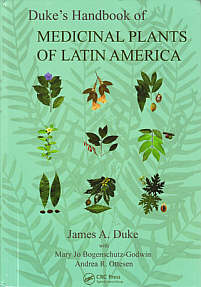
Medicinal Activities
 Further information for practitioners: Further information for practitioners:
World-famous botanist Dr. James Duke attributes the following activities
to this plant (p. 457-460; see hardcopy cover at right),
drawn from the extant literature. (See his graduation for "level of
efficacy" on our amazon traditionals page;
followed by Duke's bibliographic abbreviations (in capital letters),
which we identify
on a separate page.)
 Duke provides a " food farmacy potential" score for this
plant of "FNFF=?."
- Abortifacient (1; RAI)
- Alterative (f; DAW)
- Antiabortive (f; JFM)
- Antiinflammatory (f; KAB)
- Antiseptic (f1; X8843942)
- Antispasmodic (1; RAI)
- Antiviral (1; RAI; X1482397)
- Aperient (f; DEP)
- Aphrodisiac (f; NPM)
- Bactericide (1; RAI)
- Candidicide (1; X1277746)
- Carminative (f; DAW; VOD)
- Cathartic (f; DAW)
- Cicatrizant (f; VOD)
- Digestive (f1; RAI)
- Diuretic (f; DAV; EGG; RAI; RAR)
- Fungicide (1; RAI; X1277746)
- Hemostat (f; JFM)
- Hydragogue (f; DAW; EFS)
- Laxative (f; JFM; RAI)
- Neurotoxic (1; RAI)
- Parasiticide (1; RAI)
- Purgative (f; JFM; NAD; RAR; VOD)
- Ribosome-Inactivator (1; X1482397)
- Sialagogue (1; WOI)
- Stomachic (f; DAW; VOD)
- Suppurative (f; DEP; NAD)
- Tonic (f; DAW; DEP)
- Uterotonic (1; RAI)
- Vermifuge (f; DAW; EFS)
- Vulnerary (f; VOD)
Indications
 Further information for practitioners: Further information for practitioners:
Duke provides the following indications for this plant:
- Abortion (f; JFM)
- Abcesses (f; DAW; DEP; NPM)
- Acne (f; DAW)
- Arthrosis (f; RAI)
- Bacteria (1; RAI; X1719209)
- Bleeding (f; JFM)
- Blisters (f; SKJ)
- Boils (f; DAW; DEP; NPM)
- Bruises (f; DAW; DEP; JFM; NAD)
- Bubo (f; NAD)
- Burns (f; RAI)
- Cancer (f; DAW; JLH)
- Candida (1; RAI; X1277746)
- Carbuncles (f; NAD)
- Chagas (f; RAI)
- Childbirth (f; RAI)
- Colds (f; RAI)
- Colic (f; JFM; RAI)
- Conjuctivosis (f; JFM; RAI)
- Constipation (f; DEP; JFM; MAX; RAI)
- Dermatosis (f; JFM; RAI)
- Diabetes (f; DAW)
- Diarrhea (f; JFM; NPM)
- Dropsy (f; DAW; NPM)
- Dysentery (f; JFM; RAI)
- Dysmenorrhea (f; NPM; RAI)
- Dyspepsia (f; NPM; VOD)
- Dysuria (f; RAI)
- Earache (f; JFM; RAI)
- Eczema (f; RAI)
- Edema (f; JFM; RAI)
- Enterosis (f; JFM; RAI)
- Escherichia (1; X1719209)
- Fever (f; JFM)
- Flu (f; RAI)
- Fracture (f; RAI)
- Freckles (f; RAI)
- Fungus (f1; JFM; RAI; X1277746)
- Gas (f; DAW; RAI; VOD)
- Gonorrhea (f; RAI)
- Headache (f; RAI)
- Hepatosis (f; DAW; RAI; VOD)
- Herpes (f; DAW; RAI)
- Hives (f; RAI)
- Hypochondria (f; DAW; RAI)
- Impotence (f; NPM)
- Infection (f1; RAI; X1277746; X1719209; X8843942)
- Inflammation (f; DAA; JFM; KAB)
- Itch (f; DAW; NAD;)
- Leprosy (f; RAI)
- Leucorrhea (f; DAA; JFM)
- Mycosis (f; JFM; RAI; X1277746)
- Myosis (f; NPM)
- Otosis (f; JFM)
- Pain (f; RAI)
- Parasites (f; RAI)
- Parotitis (f; RAI)
- Respirosis (f; RAI)
- Ringworm (f; JFM; RAI)
- Scabies (f; NPM)
- Scrofula (f; RAI)
- Sores (f; DAW; DEP; JFM; KAB)
- Spasms (f1; RAI)
- Splenosis (f; DAW; RAI)
- Sprains (f; VOD)
- Strain (f; DAW)
- Swelling (f; JFM; NPM)
- Syphilis (f; JFM)
- Thrush (f; RAI)
- Tumors (f; RAI)
- Urogenitosis (f; RAI)
- Urticaria (f; NAD)
- Uterosis (f; JFM)
- Vaginosis (f; RAI)
- VD (f; JFM)
- Viruses (1; RAI; X1482397; X1719209)
- Whitlow (f; JLH, KAB)
- Worms (f; DAW; RAI; VOD)
- Wounds (f; DAW; NAD; RAI; VOD)
- Yeast (1; RAI; X1277746)
|
 To U.S. Users: To U.S. Users: This product
have not been evaluated by the U.S. Food & Drug Administration.
It is not intended to diagnose, treat, cure, or prevent any disease.
|
 Recent Studies on Clavillia
Recent Studies on Clavillia
Sourced from PubMed
 Disclaimer: Disclaimer: The following citations provide findings on the
properties of Clavillia and offer insights into prospective areas of future research.
These findings should not be inferred to provide the basis of medicinal claims,
nor should they be relied upon by the public, as such. Readers who want full access to
the PubMed database are encouraged to
register with NCBI.
 As of Jan. 2017, there were
86 citations on PubMed for Mirabilis jalapa.
Below we list a few of the more notable:
-
Isolation and characterization of bioactive components from Mirabilis jalapa L. radix. (2015)
-
Proliferative effect of plants used for wound healing in Rio Grande do Sul state, Brazil. (2015)
[COMMENT: Out of 117 plant species from 85 genera studied, Mirabilis jalapa was one of only
four plants found to "influence positively cell proliferation."]
-
Anti-inflammatory activity of mirabilis jalapa linn. Leaves.
[ABSTRACT:Mirabilis Jalapa Linn. is a widely used traditional medicine in many parts of the world for the treatment of various diseases
viz. virus inhibitory activity, anti tumour activity. It is claimed in traditional medicine that the leaves of the plant are used in the treatment
of inflammation. In the present study, the total alcoholic extract and successive petroleum ether fractions of leaves of Mirabilis Jalapa Linn were
screened for its anti-inflammatory activity using carageenan induced rat paw edema and cotton pellet induced granuloma models. The total alcoholic
extract at the dose of 300 mg/kg p.o and successive petroleum ether fraction at the dose of 200 mg/kg exhibited significant anti-inflammatory activity
in carrageenan induced paw edema model (p<0.01). In cotton pellet granuloma model, the total alcoholic extract at the dose of 300 mg/kg and
successive petroleum ether fraction at the dose of 200 mg/kg inhibited granuloma formation significantly (p<0.05) indicating that both test samples
inhibit the increase in number of fibroblasts and synthesis of collagen and mucopolysaccharides during granuloma tissue formation during the chronic
inflammation. These experimental results have established a pharmacological evidence for the folklore claim of the drug to be used as an anti
inflammatory agent.]
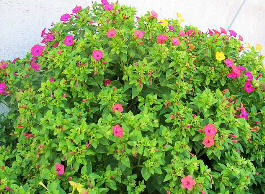
-
Antinociceptive activity of Mirabilis jalapa in mice.
[CONCLUSION: Our results demonstrate that Mirabilis jalapa presents antinociceptive activity in mice, which supports its folkloric use as
an analgesic.]
-
Pharmacological study of antispasmodic activity of Mirabilis jalapa Linn flowers. (2008)
[INTRODUCTION: Mirabilis jalapa Linn is a well-studied plant. The indigenous people of Mexico use Mirabilis jalapa to cure many
infirmities including dysentery, diarrhea, muscular pain and abdominal colic. In the present investigation, we have further characterized some
pharmacological properties of an extract of Mirabilis jalapa flowers; therefore, we intend to contribute to understand the pharmacological effects
and clarify the complex use of this medicinal plant.]
-
Anti-inflammatory activity of aqueous extract of Mirabilis jalapa Linn. leaves.
[BACKGROUND:The objective of the present study was to evaluate the anti-inflammatory activity of aqueous extract of Mirabilis jalapa Linn.
(MJL)(Nyctaginaceae) leaves for scientific validation of the folklore claim of the plant. The leaves are used as traditional folk medicine in the south
of Brazil to treat inflammatory and painful diseases. Cosmetic or dermo-pharmaceutical compositions containing MJL are claimed to be useful against
inflammation and dry skin. CONCLUSION: The results of present study demonstrate that aqueous extract of the leaves possess significant
(P < 0.05) anti-inflammatory potential.]
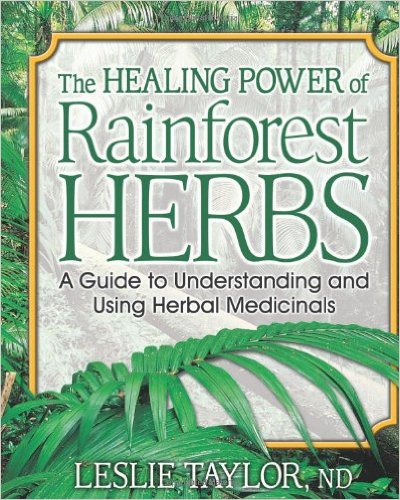
 Extensive information about
Clavillia is covered on the Raintree Forest website.
Even better, you can purchase Leslie Taylor's excellent reference book,
The Healing Power
of Rainforest Herbs: A Guide to Understanding and Using Herbal Medicinals at Amazon.
 See Clavillia article in
Wikipedia.
|





